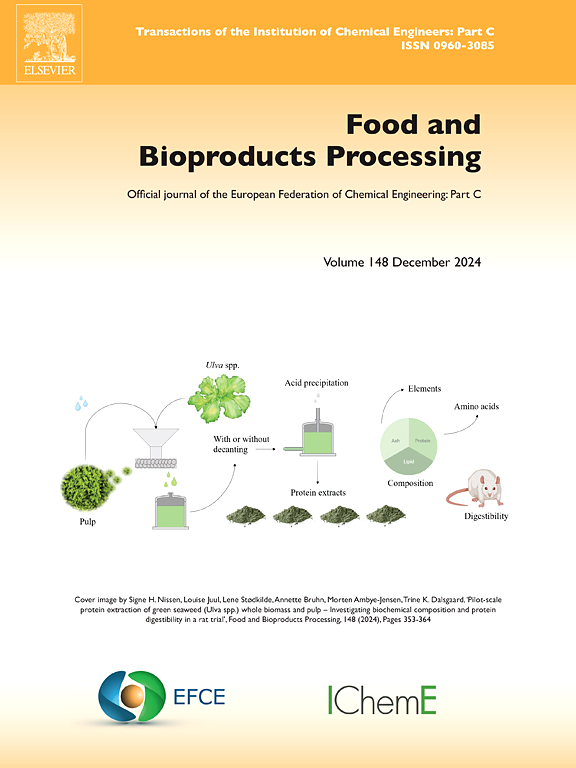利用电喷雾技术纳米封装螺旋藻 LEB 18 微藻生物质并将其应用于巧克力牛奶中
IF 3.5
2区 农林科学
Q2 BIOTECHNOLOGY & APPLIED MICROBIOLOGY
引用次数: 0
摘要
巧克力粉是一种广泛食用的食品,但其含糖量较高。微藻类螺旋藻营养价值高,可用于丰富食品。然而,微藻具有强烈的感官特征。要将其添加到食品中,就必须隐藏这些特性,例如通过纳米封装。因此,这项工作的目的是通过纳米胶囊技术开发螺旋藻生物质纳米球,并将其应用于巧克力牛奶中。这种纳米球是用壳聚糖和螺旋藻通过电喷雾技术制成的。生产纳米球的最佳参数是含有 0.50 % 壳聚糖的聚合物溶液、24 kV 的电位和 0.70 mm 的毛细管直径。这些参数使纳米颗粒更加均匀,且无残留溶剂。含有螺旋藻 LEB 18 的纳米球在约 200 °C 的温度下都很稳定。含有螺旋藻纳米球的巧克力牛奶配方中含有 5 % 的螺旋藻,与对照组相比,蛋白质含量增加了 16.3 %,脂类增加了 88.9 %,灰分增加了 33.9 %。感官分析的平均得分为 6.9 分,公众接受率为 76.3%。通过在学校膳食中加入 300 毫升含有螺旋藻纳米球的巧克力牛奶,5 岁以下儿童(体重约为 18 千克)只需一次食用就能满足其日常蛋白质需求。本文章由计算机程序翻译,如有差异,请以英文原文为准。
Nanoencapsulation of Spirulina sp. LEB 18 microalgae biomass using electrospray technique and application in chocolate milk
Chocolate powder is a widely consumed food, but it has a high sugar content. Spirulina microalgae contains high nutritional value and can be used to enrich foods. However, microalgae has strong sensory characteristics. To add it to food, it is necessary to hide these characteristics, such as through nanoencapsulation. Therefore, the objective of this work was to develop nanospheres with Spirulina biomass by nanoencapsulation and apply them in chocolate milk. This nanospheres were produced through the electrospraying technique, with chitosan and Spirulina. The best parameters to produce nanospheres were a polymeric solution with 0.50 % chitosan, electric potential of 24 kV, and capillary diameter of 0.70 mm. These resulted in more uniform nanoparticles without the presence of a residual solvent. Nanospheres with Spirulina sp. LEB 18 are stable up to approximately 200 °C. Chocolate milk containing nanospheres with Spirulina was formulated to contain 5 % Spirulina, which increased the protein content by 16.3 %, lipids by 88.9 % and ash by 33.9 % in this food compared to the control. It received an average score of 6.9 in the sensory analysis and had a public acceptance rate of 76.3 %. By incorporating 300 mL of chocolate milk containing nanospheres with Spirulina into school meals, children up to 5 years old (weighing approximately 18 kg) meet their daily protein requirement in a single serving.
求助全文
通过发布文献求助,成功后即可免费获取论文全文。
去求助
来源期刊

Food and Bioproducts Processing
工程技术-工程:化工
CiteScore
9.70
自引率
4.30%
发文量
115
审稿时长
24 days
期刊介绍:
Official Journal of the European Federation of Chemical Engineering:
Part C
FBP aims to be the principal international journal for publication of high quality, original papers in the branches of engineering and science dedicated to the safe processing of biological products. It is the only journal to exploit the synergy between biotechnology, bioprocessing and food engineering.
Papers showing how research results can be used in engineering design, and accounts of experimental or theoretical research work bringing new perspectives to established principles, highlighting unsolved problems or indicating directions for future research, are particularly welcome. Contributions that deal with new developments in equipment or processes and that can be given quantitative expression are encouraged. The journal is especially interested in papers that extend the boundaries of food and bioproducts processing.
The journal has a strong emphasis on the interface between engineering and food or bioproducts. Papers that are not likely to be published are those:
• Primarily concerned with food formulation
• That use experimental design techniques to obtain response surfaces but gain little insight from them
• That are empirical and ignore established mechanistic models, e.g., empirical drying curves
• That are primarily concerned about sensory evaluation and colour
• Concern the extraction, encapsulation and/or antioxidant activity of a specific biological material without providing insight that could be applied to a similar but different material,
• Containing only chemical analyses of biological materials.
 求助内容:
求助内容: 应助结果提醒方式:
应助结果提醒方式:


